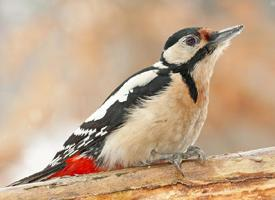
Weights and measures
| Length | 32 cm |
|---|
Animal description
The Northern flicker (Colaptes auratus) is a medium-sized member of the woodpecker family, renowned for its striking appearance and unique behaviors. This bird species is native to most of North America, parts of Central America, Cuba, and the Cayman Islands. It exhibits a remarkable adaptability to different habitats, thriving in forests, woodlands, savannas, and even residential areas, as long as there are trees or wooden structures available for nesting.One of the most distinctive features of the Northern flicker is its colorful plumage. The bird displays a rich brown back, speckled with black spots, bars, and crescents, creating a beautiful mosaic that camouflages it against the bark of trees. Its underbelly is a vivid white or light tan, dramatically contrasted with a black bib. A standout feature in many subspecies is a bright red or orange patch on the nape, which flashes brilliantly during flight or when the bird is alarmed. Males and females can be distinguished by the presence of a mustache-like mark by the beak; in males, this mark is black or red, while females typically lack this feature or it is less pronounced.
The Northern flicker has two primary color variations or "morphs" - the yellow-shafted flicker found in the eastern and northern parts of its range, and the red-shafted flicker found in the western regions. These names refer to the colors of the flight feather shafts, visible when the bird is in flight. The yellow-shafted flicker has vibrant yellow underwings and tail feathers, while the red-shafted counterpart boasts a striking red.
Unlike many woodpecker species, Northern flickers often feed on the ground. Their diet primarily consists of ants and beetles, which they forage with their slightly curved, sharp bill. They have a long, sticky tongue, capable of reaching deep into ant colonies or crevices in bark to extract insects. This adaptation allows them to consume a significant amount of ants, making these insects a staple of their diet. However, they also eat fruits and seeds, especially in the winter months when insects are less abundant.
The call of the Northern flicker is a loud, rolling 'wick-wick-wick' sound, and during the mating season, males perform a remarkable 'drumming' display on resonant surfaces to attract females and establish territory. This behavior is not only a means of communication but also a demonstration of the bird's health and vigor.
In terms of reproduction, Northern flickers are cavity nesters, often excavating their own nesting sites in dead or diseased trees. They can also reuse cavities from previous years or take over those made by other species. A typical clutch consists of 6 to 8 eggs, which are incubated primarily by the female. Both parents share the duty of feeding the chicks until they are ready to fledge, which occurs about 4 weeks after hatching.
Northern flickers play a significant role in their ecosystems, not only as predators of ants and other insects but also as creators of nesting cavities that are later used by other bird species that are unable to excavate their own. Despite facing threats from habitat loss and competition for nesting sites, the Northern flicker remains a common and widespread species, much admired by birdwatchers and nature enthusiasts for its beauty and ecological importance.
Map of occurrence

Similar Animals
New photos of animals
Top 10 animals
- Dolphin gull (Leucophaeus scoresbii)
- Diana monkey (Cercopithecus diana)
- Moustached guenon (Cercopithecus cephus)
- Galápagos tortoise (Geochelone nigra complex)
- Russian tortoise (Testudo horsfieldii)
- Japanese macaque (Macaca fuscata)
- Stone loach (Barbatula barbatula)
- Greek tortoise (Testudo graeca)
- Common flying dragon (Draco volans)
- Colossal squid (Mesonychoteuthis hamiltoni)


